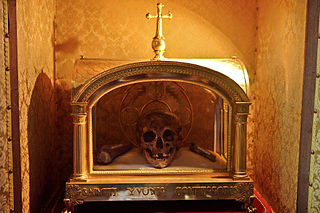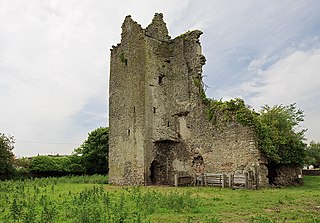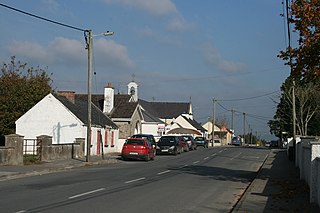
In religion, a relic is an object or article of religious significance from the past. It usually consists of the physical remains or personal effects of a saint or other person preserved for the purpose of veneration as a tangible memorial. Relics are an important aspect of some forms of Buddhism, Christianity, Islam, shamanism, and many other religions. Relic derives from the Latin reliquiae, meaning "remains", and a form of the Latin verb relinquere, to "leave behind, or abandon". A reliquary is a shrine that houses one or more religious relics.

The True Cross is said to be the real cross on which Jesus of Nazareth was crucified, according to Christian tradition.

Ardfert is a village and civil parish in County Kerry, Ireland. Historically a religious centre, the economy of the locality is driven by agriculture and its position as a dormitory town, being only 8 km (5 mi) from Tralee. The population of the village was 749 at the 2016 census.

The Flight of the Earls took place in September 1607, when Hugh O'Neill, Earl of Tyrone, and Rory O'Donnell, 1st Earl of Tyrconnell, and about ninety followers, left Ulster in Ireland for mainland Europe. Their permanent exile was a watershed event in Irish history, symbolizing the end of the old Gaelic order.

Rory O'Donnell, 1st Earl of Tyrconnell, was an Irish Gaelic lord and the last King of Tyrconnell prior to the Plantation of Ulster. He succeeded his older brother Hugh Roe O'Donnell and in 1603 became the first to be styled the Earl of Tyrconnell. In 1607, following their defeat in the Nine Years' War, Tyrconnell and his wartime ally Hugh O'Neill, Earl of Tyrone, fled Ireland for mainland Europe. Tyrconnell died of a fever shortly after settling in Rome.

Cashel is a town in County Tipperary in Ireland. Its population was 4,422 in the 2016 census. The town gives its name to the ecclesiastical province of Cashel. Additionally, the cathedra of the Roman Catholic Archdiocese of Cashel and Emly was originally in the town prior to the English Reformation. It is part of the parish of Cashel and Rosegreen in the same archdiocese. One of the six cathedrals of the Anglican Bishop of Cashel and Ossory, who currently resides in Kilkenny, is located in the town. It is in the civil parish of St. Patricksrock which is in the historical barony of Middle Third.

Hugh Roe O'Donnell II, also known as Red Hugh O'Donnell, was an Irish clan chief, Lord of Tyrconnell, and senior leader of the Irish confederacy during the Nine Years' War.

The O'Donnell dynasty were the dominant Irish clan of the kingdom of Tyrconnell in Ulster in the north of medieval and early modern Ireland.

Borrisoleigh is a small town in County Tipperary, Ireland. At the 2016 census, it had a population of 679. It is in the ecclesiastical parish of Borrisoleigh and Ileigh in the Roman Catholic Archdiocese of Cashel and Emly.
Clonoulty is a small village and a civil parish in County Tipperary, Ireland. It is one of nine civil parishes in the barony of Kilnamanagh Lower. It is also one half of the ecclesiastical parish of Clonoulty-Rossmore in the Roman Catholic Archdiocese of Cashel and Emly. Clonoulty may also refer to a slightly larger area which forms one half of the catchment area for Clonoulty-Rossmore GAA club.

Holycross is a village and civil parish in County Tipperary, Ireland. It is one of 21 civil parishes in the barony of Eliogarty. The civil parish straddles the baronies of Eliogarty and of Middle Third. It is also an ecclesiastical parish in the Roman Catholic Archdiocese of Cashel and Emly.
Events from the year 1540 in Ireland.

The R660 road is a regional road in County Tipperary, Ireland, which runs south–north from the Cashel to Thurles. En route it passes through the village of Holycross, where it crosses the River Suir and passes the walls of Holy Cross Abbey. The route is 21 km (13 mi) long.

Gortnahoe, also known as Gortnahoo, is a village in County Tipperary, Ireland. It is located on the R689 regional road 6 km (3.7 mi) south of Urlingford, County Kilkenny. It is 3 km (1.9 mi) southeast of the N8 Dublin - Cork road. Gortnahoe, pronounced "Gurt/na/hoo" by the locals, is part of the parish of Gortnahoe–Glengoole.
Events from the year 1601 in Ireland.
The Holyrood or Holy Rood is a Christian relic alleged to be part of the True Cross on which Jesus died. The word derives from the Old English rood, meaning a pole and the cross, via Middle English, or the Scots haly ruid. Several relics venerated as part of the True Cross are known by this name, in England, Ireland and Scotland.
Middle Third is a barony in County Tipperary, Ireland. This geographical unit of land is one of 12 baronies in County Tipperary. Its chief town is Cashel. The barony lies between Eliogarty to the north, Iffa and Offa East to the south, Clanwilliam to the west and Slievardagh to the east. It is currently administered by Tipperary County Council.

Donegal Abbey is a ruined Franciscan Priory in Donegal in Ireland. It was constructed by the O'Donnell dynasty in the fifteenth century and remained a center of Classical Christian education even after its destruction during the Nine Years War. It is sometimes referred to as Donegal Friary.

Thomas Morris, D.D. KC*HS, was the Catholic Archbishop of Cashel and Emly in Ireland from 1959 to 1988.

























